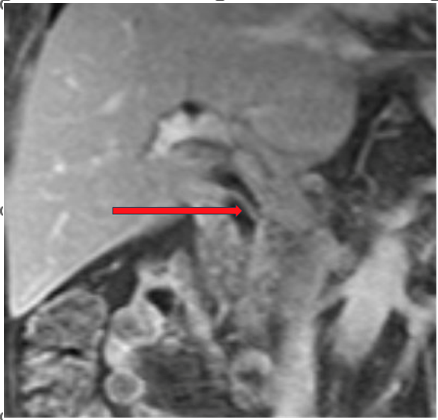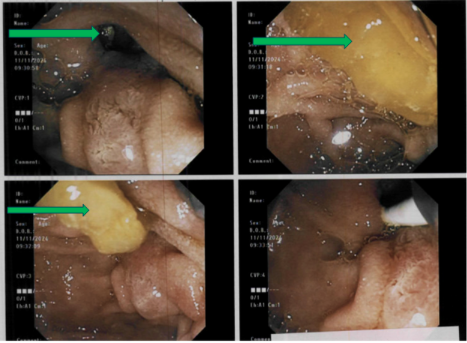Monday Poster Session
Category: Biliary/Pancreas
P2256 - Unusual CBD Obstruction by Vegetable Matter Mimicking a Stent: A Rare Complication of Precut and Recurrent ERCPs
Monday, October 27, 2025
10:30 AM - 4:00 PM PDT
Location: Exhibit Hall

Naga Vamsi Krishna Machineni, MD (he/him/his)
Appalachian Regional Healthcare
Harlan, KY
Presenting Author(s)
Naga Vamsi Krishna Machineni, MD1, Midila Bapineni, MD1, Anjali Desai, MD1, Anusha Tipparthi, MD1, Gary Sinensky, MD2, Stephen James Mularz, DO2
1Appalachian Regional Healthcare, Harlan, KY; 2Appalachian Regional Healthcare, Hazard, KY
Introduction: Choledocholithiasis is one of the most common causes of hospitalization with abdominal pain and jaundice. However, obstruction of the Common bile duct (CBD) by a foreign body is very rare. Today, we present a unique case of CBD occlusion caused by vegetable matter.
Case Description/
Methods: A 72-year-old female with the past medical history of hyperlipidemia, hypertension, cholecystectomy (30 years ago), and multiple ERCPs for recurrent choledocholithiasis, presented to the gastroenterology clinic for evaluation of epigastric and right upper quadrant pain. The patient was admitted for acute cholangitis due to a CBD stone 5 months ago, which was treated with ERCP and stent placement, with the stent subsequently removed 4 weeks later. Liver enzymes (AST, ALT) and Alkaline phosphatase (ALP) have normalized after ERCP. But the patient started complaining of pain in the right upper quadrant and was presented to the clinic again after 2 months. An MRI [Image 1] was ordered, which showed a dilated CBD with stent-like material in the CBD. Upon repeating the ERCP, linear legume sludge-like vegetable matter was extracted from the duct after sweeping the duct with an 18mm balloon dilation, which mimicked a stent in MRI [Image 2].
Discussion: This is the first documented case of CBD obstruction due to vegetable matter or a bean. There were sporadic case reports on presence of parasites, fish bones, fragments of T tubes, rubber objects, shrapnel, metal clips, migrated stents, surgical gauze, and non-absorbable suture material, all of which can serve as a nuclei for formation of stones or molds in the bile duct [1].
CBD stone recurrence is common, with the recurrence rate following ERCP being between 2% and 22%. The likelihood of recurrence increases with each subsequent episode. Age > 65 years, presence of a stent or T-tube placement in the CBD, wide CBD (diameter ≥ 10 mm), gallbladder stones, history of cholecystectomy are independent risk factors for recurrent CBD stones [2].
In this case, age >65 yrs, precut during ERCP, h/o of multiple ERCPs, and stent placement puts this patient at high risk for retrograde flow of the food materials into the dilated CBD or pancreatic duct, leading to obstruction. All the above factors made the CBD a potential lumen to accommodate the food particulate matter, which further obstructed biliary flow and caused clinical symptoms. This case highlights the importance of increased risk of pancreatitis or acute cholangitis after recurrent ERCPs.

Figure: Image 1: T1 MRI: dilated CBD and vegetable matter mimicking stent in CBD (red arrow).

Figure: Image 2: ERCP images showing foreign body in papilla, and yellowish vegetable material after balloon dilation and sweeping.
Disclosures:
Naga Vamsi Krishna Machineni indicated no relevant financial relationships.
Midila Bapineni indicated no relevant financial relationships.
Anjali Desai indicated no relevant financial relationships.
Anusha Tipparthi indicated no relevant financial relationships.
Gary Sinensky indicated no relevant financial relationships.
Stephen James Mularz indicated no relevant financial relationships.
Naga Vamsi Krishna Machineni, MD1, Midila Bapineni, MD1, Anjali Desai, MD1, Anusha Tipparthi, MD1, Gary Sinensky, MD2, Stephen James Mularz, DO2. P2256 - Unusual CBD Obstruction by Vegetable Matter Mimicking a Stent: A Rare Complication of Precut and Recurrent ERCPs, ACG 2025 Annual Scientific Meeting Abstracts. Phoenix, AZ: American College of Gastroenterology.
1Appalachian Regional Healthcare, Harlan, KY; 2Appalachian Regional Healthcare, Hazard, KY
Introduction: Choledocholithiasis is one of the most common causes of hospitalization with abdominal pain and jaundice. However, obstruction of the Common bile duct (CBD) by a foreign body is very rare. Today, we present a unique case of CBD occlusion caused by vegetable matter.
Case Description/
Methods: A 72-year-old female with the past medical history of hyperlipidemia, hypertension, cholecystectomy (30 years ago), and multiple ERCPs for recurrent choledocholithiasis, presented to the gastroenterology clinic for evaluation of epigastric and right upper quadrant pain. The patient was admitted for acute cholangitis due to a CBD stone 5 months ago, which was treated with ERCP and stent placement, with the stent subsequently removed 4 weeks later. Liver enzymes (AST, ALT) and Alkaline phosphatase (ALP) have normalized after ERCP. But the patient started complaining of pain in the right upper quadrant and was presented to the clinic again after 2 months. An MRI [Image 1] was ordered, which showed a dilated CBD with stent-like material in the CBD. Upon repeating the ERCP, linear legume sludge-like vegetable matter was extracted from the duct after sweeping the duct with an 18mm balloon dilation, which mimicked a stent in MRI [Image 2].
Discussion: This is the first documented case of CBD obstruction due to vegetable matter or a bean. There were sporadic case reports on presence of parasites, fish bones, fragments of T tubes, rubber objects, shrapnel, metal clips, migrated stents, surgical gauze, and non-absorbable suture material, all of which can serve as a nuclei for formation of stones or molds in the bile duct [1].
CBD stone recurrence is common, with the recurrence rate following ERCP being between 2% and 22%. The likelihood of recurrence increases with each subsequent episode. Age > 65 years, presence of a stent or T-tube placement in the CBD, wide CBD (diameter ≥ 10 mm), gallbladder stones, history of cholecystectomy are independent risk factors for recurrent CBD stones [2].
In this case, age >65 yrs, precut during ERCP, h/o of multiple ERCPs, and stent placement puts this patient at high risk for retrograde flow of the food materials into the dilated CBD or pancreatic duct, leading to obstruction. All the above factors made the CBD a potential lumen to accommodate the food particulate matter, which further obstructed biliary flow and caused clinical symptoms. This case highlights the importance of increased risk of pancreatitis or acute cholangitis after recurrent ERCPs.

Figure: Image 1: T1 MRI: dilated CBD and vegetable matter mimicking stent in CBD (red arrow).

Figure: Image 2: ERCP images showing foreign body in papilla, and yellowish vegetable material after balloon dilation and sweeping.
Disclosures:
Naga Vamsi Krishna Machineni indicated no relevant financial relationships.
Midila Bapineni indicated no relevant financial relationships.
Anjali Desai indicated no relevant financial relationships.
Anusha Tipparthi indicated no relevant financial relationships.
Gary Sinensky indicated no relevant financial relationships.
Stephen James Mularz indicated no relevant financial relationships.
Naga Vamsi Krishna Machineni, MD1, Midila Bapineni, MD1, Anjali Desai, MD1, Anusha Tipparthi, MD1, Gary Sinensky, MD2, Stephen James Mularz, DO2. P2256 - Unusual CBD Obstruction by Vegetable Matter Mimicking a Stent: A Rare Complication of Precut and Recurrent ERCPs, ACG 2025 Annual Scientific Meeting Abstracts. Phoenix, AZ: American College of Gastroenterology.

